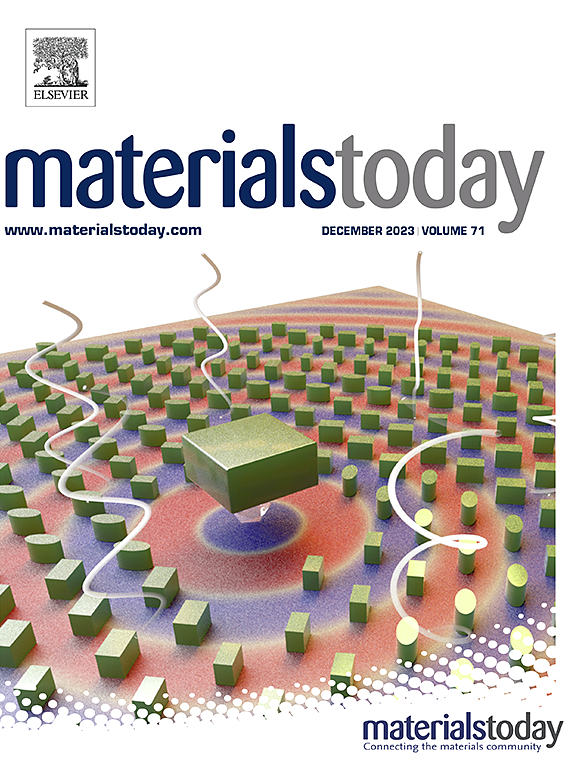Achieving the strength and ductility synergy in a steel through nanoprecipitation and its induced grain refinement
IF 21.1
1区 材料科学
Q1 MATERIALS SCIENCE, MULTIDISCIPLINARY
引用次数: 0
Abstract
There is a constant demand in human society to develop steels with superior strength and ductility. The strength-ductility trade-off is hardly broken by using one of the four traditional strengthening methods solely, namely, strain hardening, grain refinement, precipitation and solid solution strengthening. The design and development of advanced steels need to introduce as many strengthening mechanisms as possible for achieving desirable strength. To achieve good ductility with high uniform elongation before fracture, necking need to be suppressed by continuous work hardening of the material. Here, we demonstrate that by adding Al (∼6%) and Ti (∼3%) into the Fe-26Ni-1.2C (at.%) steel, nanosized γ′-(Ni, Fe)3(Al, Ti) (∼20 vol%) can precipitate out in the initial austenitic matrix after one-step aging. The formation of γ′ nanoprecipitates triggers γ → α phase transformation of the matrix during cooling, introducing strain hardening due to volume expansion, and simultaneously refines grains from 15 to 1–2 μm due to the hindering effect of nanoprecipitates on grain boundary migration. Moreover, the γ′ nanoprecipitates not only can hinder dislocation motion in the matrix, but also can plastically deform under high stress to enhance the ductility of the steel. Therefore, the nanoprecipitate-strengthening ultrafine-grained steel suppresses necking instability, which enhances the strength, uniform elongation and work hardening capability simultaneously.

通过纳米沉淀及其诱导的晶粒细化实现钢的强度和延展性协同作用
人类社会不断要求开发出具有优异强度和延展性的钢材。仅采用应变硬化、晶粒细化、析出和固溶强化四种传统强化方法中的一种,很难打破强度与塑性之间的权衡关系。先进钢的设计和开发需要引入尽可能多的强化机制,以达到理想的强度。为了在断裂前获得高均匀伸长率的良好延展性,需要通过材料的连续加工硬化来抑制颈缩。在这里,我们证明了在Fe- 26ni -1.2 c (at.%)钢中加入Al(~ 6%)和Ti(~ 3%),纳米级γ′-(Ni, Fe)3(Al, Ti) (~ 20 vol%)在一步时效后可以在初始奥氏体基体中析出。在冷却过程中,γ′纳米沉淀的形成引发基体的γ→α相变,由于体积膨胀导致应变硬化,同时由于纳米沉淀对晶界迁移的阻碍作用,晶粒从15 μm细化到1-2 μm。此外,γ′纳米沉淀不仅可以阻碍基体中的位错运动,还可以在高应力下进行塑性变形,从而提高钢的延展性。因此,纳米沉淀强化超细晶钢抑制了颈缩失稳,同时提高了强度、均匀伸长率和加工硬化能力。
本文章由计算机程序翻译,如有差异,请以英文原文为准。
求助全文
约1分钟内获得全文
求助全文
来源期刊

Materials Today
工程技术-材料科学:综合
CiteScore
36.30
自引率
1.20%
发文量
237
审稿时长
23 days
期刊介绍:
Materials Today is the leading journal in the Materials Today family, focusing on the latest and most impactful work in the materials science community. With a reputation for excellence in news and reviews, the journal has now expanded its coverage to include original research and aims to be at the forefront of the field.
We welcome comprehensive articles, short communications, and review articles from established leaders in the rapidly evolving fields of materials science and related disciplines. We strive to provide authors with rigorous peer review, fast publication, and maximum exposure for their work. While we only accept the most significant manuscripts, our speedy evaluation process ensures that there are no unnecessary publication delays.
 求助内容:
求助内容: 应助结果提醒方式:
应助结果提醒方式:


